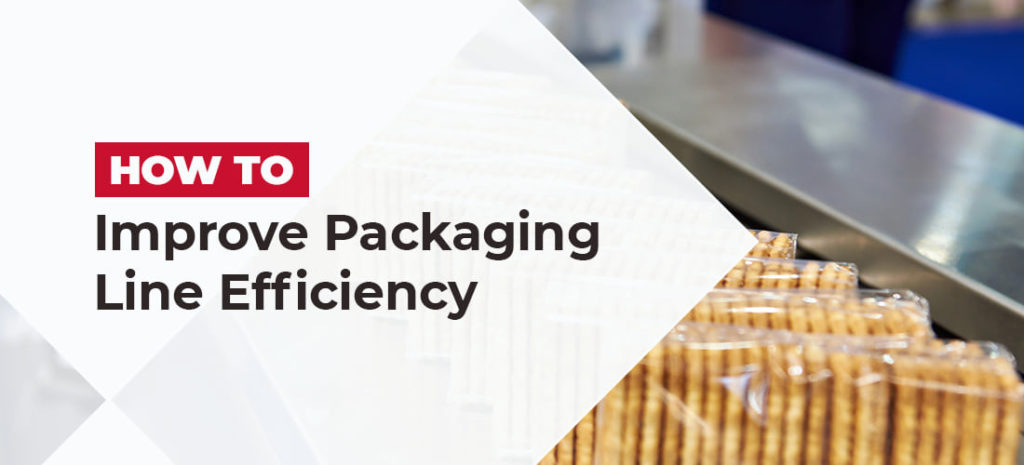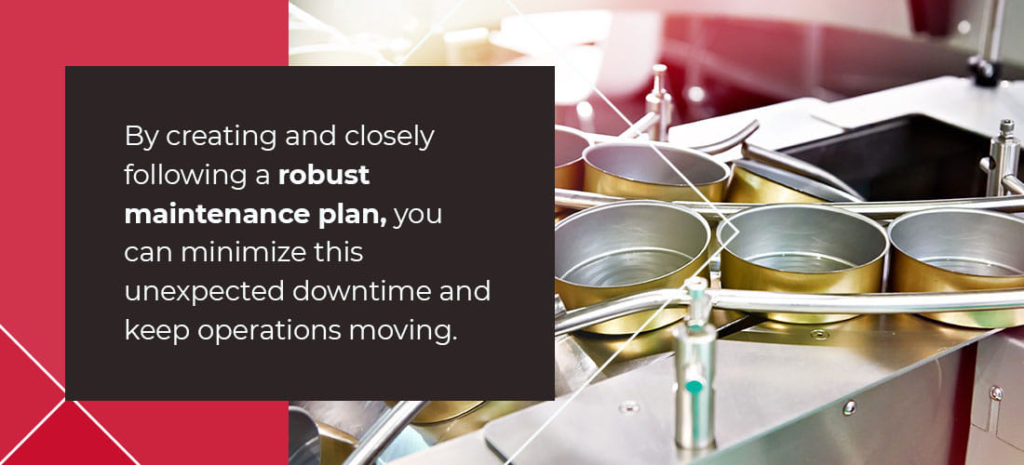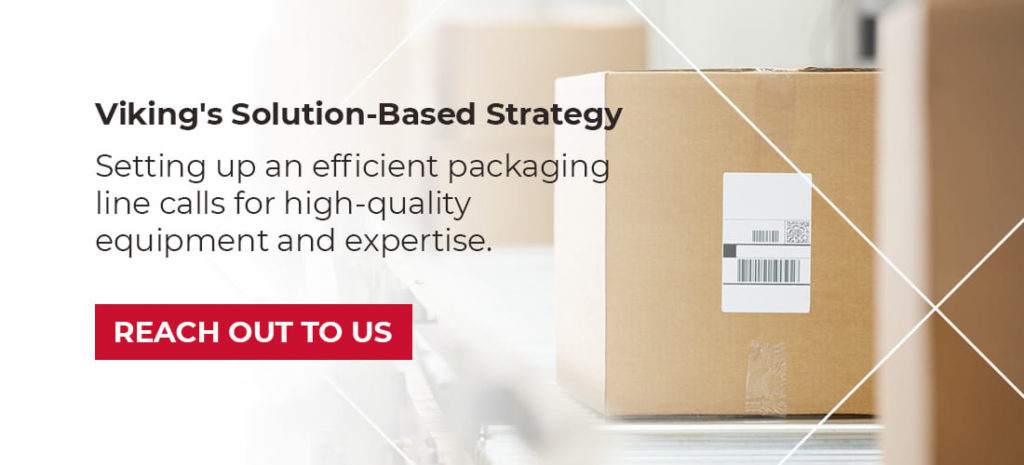How to Improve Packaging Line Efficiency

A packaging line is a significant part of getting your products out the door. It covers preparing items for distribution, including packaging the product itself and getting it ready for shipping. The packaging line is the home stretch for distributors and manufacturers. It adds protection, branding and security to the products.
Packaging lines come in many different forms and involve various types of equipment depending on the product. There are many places for problems to occur. Bottlenecks and inefficiency can slow you down and add costs through downtime, reworks, labor and other unchecked expenses.
These lines often combine automated equipment with manual processes, so everything from poor maintenance to poor training can affect packaging line efficiency. You also have the condition of your supplies to think about. Packaging materials are often made of substances that don’t respond well to humidity or spills, like cardboard. Damage can affect the equipment’s ability to operate or make it easier for manual errors to occur.
On the flip side, having many different steps means there are many ways to improve packaging efficiency. We’ve lined up some packaging line optimization tips to help you make the most of your packaging productivity.
What Is a Packaging Line?
A packaging line wraps products in a container, preparing them for shipping or sale. It can include preparing packaging materials, placing products in their containers and preparing them for shipment. The process often starts with folding flat boxes or mailers and filling them with any necessary void fills, like foam peanuts or air pillows. Then the containers are sealed with the products inside. From there, they move on to palletization or unitization, if needed.
The process can be entirely automatic or completely manual, but it often falls somewhere between, as with semi-automatic packaging lines. Automation generally helps improve efficiency, reducing the chance for manual errors and adding speed and precision. Greater automation can help improve efficiency through factors like speed, reduced labor requirements and greater uptime.
Creating a fully integrated, optimized packaging process requires careful design, assembly and programming. Good design and setup can ensure as little downtime as possible for greater productivity.
How to Improve Packaging Line Efficiency and Productivity
If you need to prevent packaging line slowdown, you can make changes in many different parts of your operation.
1. Run Differently Sized Products on Your Packaging Line
Try installing equipment that runs flexibly and allows you to work with a variety of products on one production line. You can reduce the number of machines you need for lower equipment costs and fewer maintenance demands. It becomes easy to update your line to accommodate new products.
2. Identify Downtime Drivers and Slow Processes
Take some time to learn how to measure packaging line efficiency. One of the best ways to get an overarching view of efficiency is through Overall Equipment Effectiveness (OEE). OEE measures how much of your planned production time is actually productive. You want this number to be as high as possible, but many manufacturers achieve scores from 60%-85%.
OEE is important, but it doesn’t provide the entire picture. Measure your productivity with various metrics and look for patterns that might show you which processes or equipment are slowing you down. You may find that a piece of older machinery is causing more breakdowns than your new equipment or that your supplies warp by the time they reach the packaging line. You can use these insights to make purposeful changes to your existing packaging process.
When making productivity improvements, data provides excellent insights about where to focus your efforts.
3. Try Multipacking
Pre-printed materials can help you merge bundling and branding into one process. Multipacking puts multiple products together into one container, all in one step. It can reduce the number of steps in the packaging process and help improve handling options.
4. Minimize Waste
If you’re producing excessive waste in the packaging line, you’re reducing efficiency. Waste often comes from product damage or overused material during manual product packaging. One way to mitigate waste is to switch to fully or semi-automatic packaging solutions that use more precise equipment. Other options include staff training or storage improvements.
5. Follow Proper Maintenance Procedures
Surprise breakdowns can bring the entire line to a halt. By creating and closely following a robust maintenance plan, you can minimize this unexpected downtime and keep the packaging process moving. You can also enlist predictive maintenance by monitoring your machinery to predict machine and component failure and intervene before it happens.

6. Optimize Labor
Assess your labor usage and see if there is room for improvement. Adding automatic or semi-automatic equipment can help you boost throughput and free up employees for jobs that require a human touch. Automated machinery can also reduce physical demands on employees and limit the risks of safety incidents.
7. Automate Your Operation
You can run a hands-off packaging line during non-traditional hours — such as overnight — and drastically improve your productivity. Consider upgrading to a fully-automated process that allows product packaging with little to no supervision. You can reduce labor costs while boosting your throughput.
8. Watch Your Supply Chain
Relying on third-party suppliers is unavoidable for most packaging operations. Whether they’re unable to fulfill an order or you forgot to place one, running out of supplies can be detrimental to productivity. Stay ahead of supply issues by keeping open channels of communication with your suppliers and monitoring stock levels carefully.
9. Improve Employee Training
Although it takes workers off the floor at first, better training tends to improve efficiency in a few different ways. It can help employees thoroughly understand the equipment, gain more confidence to work quickly and develop skills that can help reduce downtime, such as preventative maintenance.
Spend some time implementing new training strategies. You might find other benefits, such as better retention — training is one of the top characteristics of a job that causes employees to leave. Other benefits include possible morale boosts and higher-quality work.
10. Invest in Your Equipment
If you’re still working with old equipment, you probably have inefficiencies all over your packaging line. Along with the general aging of equipment, older machinery could be missing out on modern technologies that would help improve packaging productivity. New equipment tends to be faster, more reliable and potentially more versatile so you can optimize your packaging solutions.

Viking’s Solution-Based Strategy
A packaging line has many moving parts, with factors like equipment selection, configuration and training contributing to success. Setting up an efficient packaging line calls for high-quality equipment and expertise. Here at Viking Plastic Packaging, Inc., we take a solution-based approach. We can help you go from building a packaging line to building a highly efficient and optimized packaging line. We integrate industry-leading technology with your processes for effective automation and streamlined operations from start to finish.
We offer:
- New and used equipment: With machinery for bagging, sealing, coding, palletizing and much more, Viking can help you find and implement a comprehensive equipment solution for an automated packaging line.
- Materials: Our wide selection of packaging materials makes us a go-to provider for your ongoing supply needs.
- Parts and service: We’ll keep your equipment moving with parts, technical support and equipment refurbishing services.
- Training: Our skilled technicians can even step in to help your employees learn more about the machinery they use.
Reach out to us today to chat with a skilled technician on how to improve packaging line efficiency with Viking’s end-to-end service.